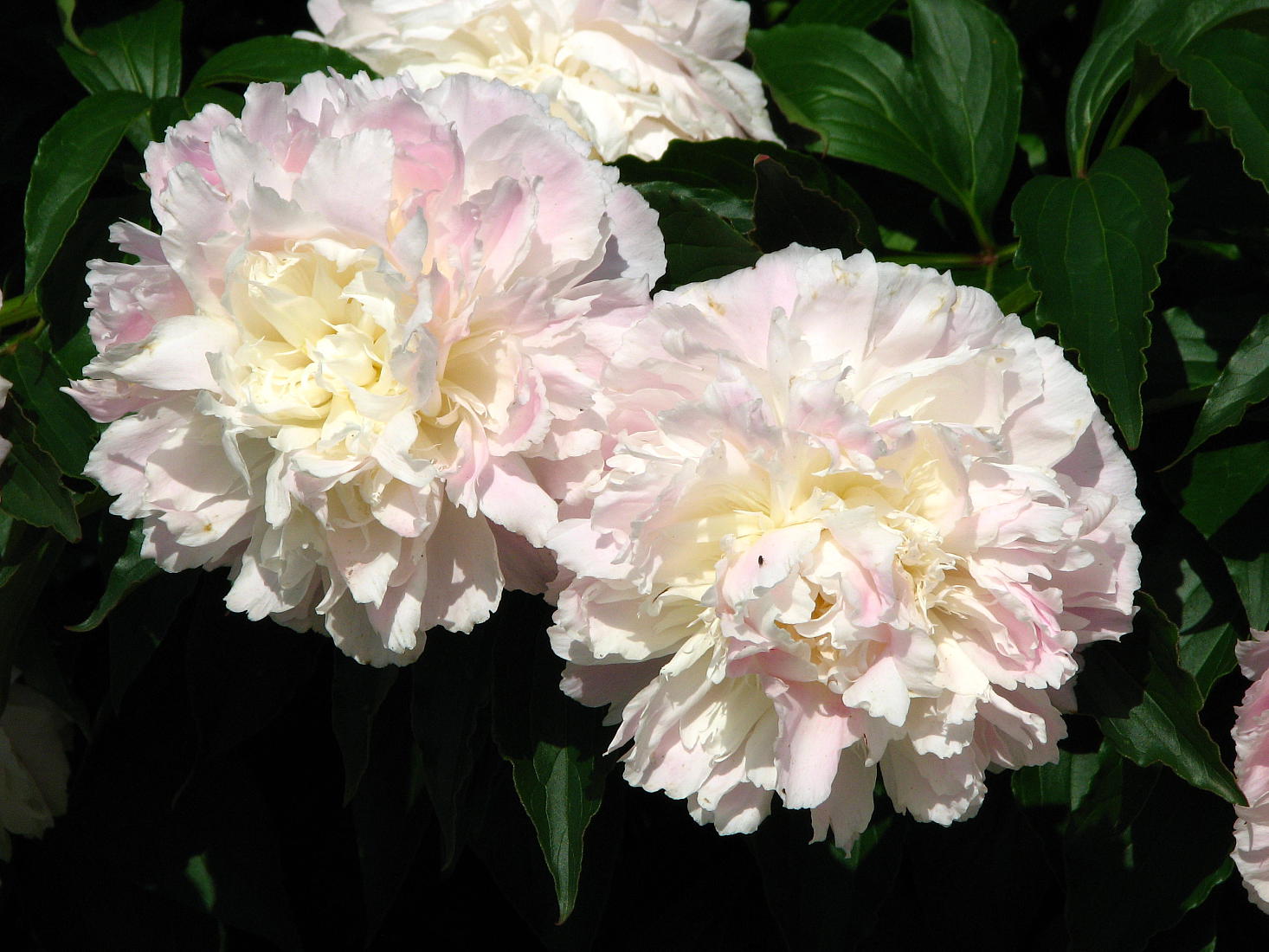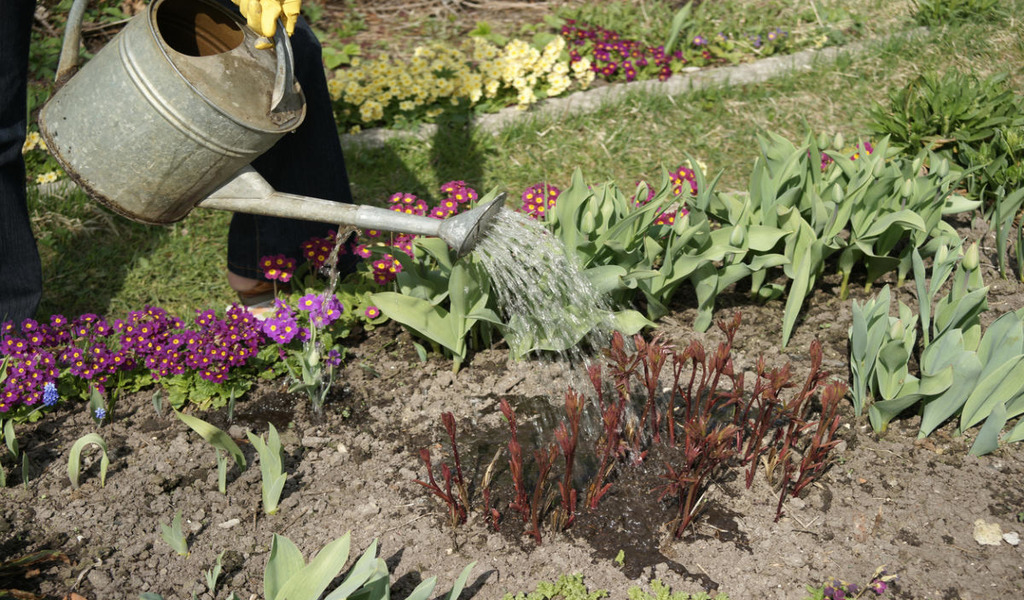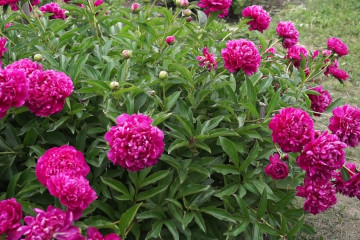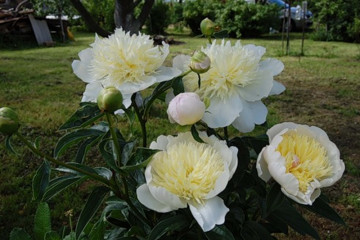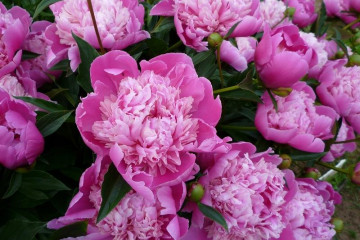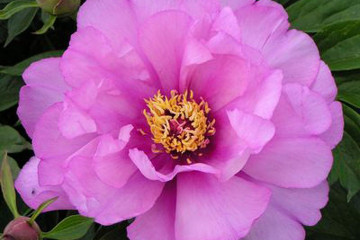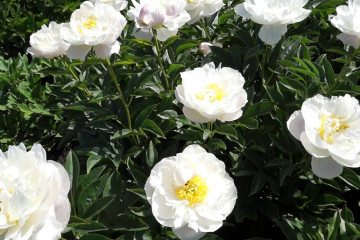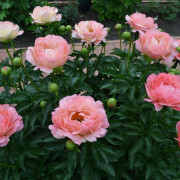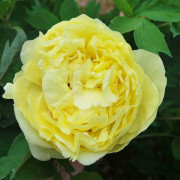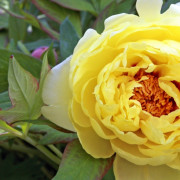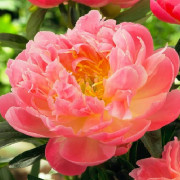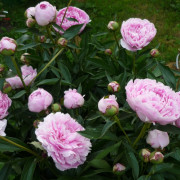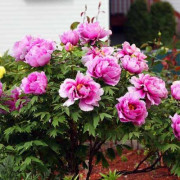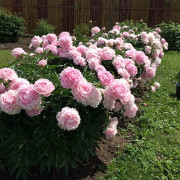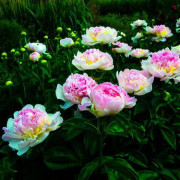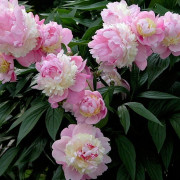Peony Shirley Temple (Paeonia Shirley Temple)
Content:
The luxurious peony of the Shirley Temple variety was named after the popular Hollywood actress and was bred in the United States in 1948. Its advantage is its luxurious appearance. The flowers are spherical and resemble roses in appearance and aroma.
Peony Shirley Temple - what is this variety, history of creation
The variety belongs to the class of herbaceous plants, the stems of adult flowers grow up to 90 cm, they are strong enough and do not fall under the weight of buds up to 20 cm in diameter.The buds themselves have a pink color, which changes to snow-white as they bloom (at the end of May). The flowers have expressive openwork leaves of a dark green hue; at the beginning of autumn they turn crimson. Due to powerful shoots, adult bushes do not need additional support.
Advantages and disadvantages
Of the advantages, a high level of frost resistance and the ability to withstand cold temperatures up to -40 ℃ are noted. Bushes can be left unprotected for the winter. Representatives of this variety are resistant to diseases and beetles. For them, plots in the garden are carefully chosen, since Shirley Temple peonies are perennial plants and can be cultivated for thirty years without the need for replanting. The species has almost no flaws except for some care requirements.
Application in landscape design
Peony Shirley Temple is actively used by landscape designers when creating various compositions. Due to the unpretentiousness of the variety, it is included in projects for garden plots. The culture is used as:
- single or group planting on lawns in combination with ground cover perennials;
- the middle part of a round flower bed in combination with bright annuals;
- lush borders of garden paths along with gladioli, foxgloves or aquilegia.
Cultivation of peonies, how to properly plant in open soil
Perennial shrubs of the Shirley Temple variety do not cause problems during planting and during the cultivation process, if it is important to observe all the subtleties, refer to the description of the Shirley Temple peony.
Planting with root cuttings
Before breeding, it is important to take a responsible approach to the choice of technique. The best option would be a vegetative breeding method. The plant is planted by cuttings, the cuttings themselves are acquired in finished form, paying special attention to the quality of planting materials. It should be free from mold and rot residues.
In what period is the landing
The Shirley Temple peony is traditionally planted in the second half of August, early September or early November. For planting, select places without wind and sun, with moderately dry soil, rich in nutrients.
Location selection
Paeonia Shirley Temple should not be planted in dense soil, it is best to choose places with slightly acidic or neutral loam, characterized by ideal air and moisture permeability. Cuttings are placed at a distance of at least three meters from tall trees and bushes, keeping a distance of one meter in a row.
How to prepare the soil and flowers for planting
For the plant, open areas are chosen, protected from the cold wind. The seedlings should be two years old and have at least 3-5 aerial shoots in combination with a perfectly developed root system. 10-14 days before planting, grooves are prepared with a width and depth of at least 60 cm, then they are filled with a soil mixture, which should include: turf, humus, peat and leafy soil.
Planting procedure step by step
Before planting, a hole is prepared, designed for further growth of the root system. In the presence of loose soil, it is advisable to supplement it with good drainage. The planting process consists of several steps:
- a small elevation is made in the center of the recess;
- a stalk is placed on it and the processes are straightened;
- buds for recovery are placed at a distance of 2-3 cm from the topsoil;
- the roots are sprinkled with soil, then the soil is compacted and moistened.
The circle near the roots is mulched with humus to prevent moisture loss from the soil layer after planting.
Seed planting
With the help of seeds, only wild species of peony are propagated. This process is time consuming and suitable for experienced gardeners. In most cases, professionals recommend breeding according to the standard method by dividing the bush.
Plant care
Peony Shirley Temple does not cause significant problems in the care process. In order for the flower to develop fully, it is provided with timely watering, the soil is fertilized and loosened in time, and the area is cleared of weeds.
Moisturizing and feeding
The bushes are watered sparingly, avoiding cracking of the soil. At the same time, the quantity and quality of irrigation is monitored in the spring. Since the beginning of September, the earth is abundantly moistened. In this case, the plant lays buds for the next year. The shrub requires at least two buckets of water. Regular fertilization is required for the plant in the third or fourth year after planting. The procedure is combined with watering. At the beginning of April, organic components are added, the soil is fertilized for the second time before the formation of inflorescences with the help of mineral dressing.
Mulching and loosening
Loosening the soil near the bushes at an average pace the next day after a rainstorm, this procedure promotes growth and improves soil nutrition. To protect the soil and improve its properties, the soil is additionally mulched with organic matter, compost or standard film.
Preventive treatment
For prevention, the area near the peonies is regularly cleaned of weeds. In the autumn, after the onset of cold weather, the sprouts above the ground are cut exactly below the soil level. The variety belongs to the category of frost-resistant shrubs, but they should still be covered on the eve of frost with a compost or humus layer.
Blooming peony Shirley Temple
The variety is referred to as "double" crops. The diameter of each flower can reach 20 cm. The color of the buds varies from pale pink to milky white, the petals for the inflorescences are straight, located on the inside and tightly adjacent to the outside.
A period of activity and rest
The Shirley Temple milk-flowered peony, like the other Lactiflora species, is considered the earliest, the primary flower buds begin to bloom in early May. The flowering period lasts at least two to three weeks, taking into account the growing conditions.
Leaving during the flowering period and after
In order for the flowers to retain their qualities, they are thoroughly watered during the flowering period and after. It is important to apply fertilizers to the soil on time, the bushes are supplemented with top dressing at the stage of bud formation.
Why peonies don't bloom, common reasons
If the bushes do not bloom, most likely the reason is a violation of the irrigation regime, improper application of fertilizers or their absence. Sometimes plants do not have enough sunlight, which provokes the lack of buds.
Peonies after flowering
When the flowering stage is over, the culture needs additional care so that the peonies retain their decorative qualities until next year.
Transfer
The transplant procedure is carried out every 4-5 years. Due to it, plants rejuvenate and grow faster. For this purpose, the bushes are dug up and divided into several fragments using a sharp tool, then they are planted in a new place.
Pruning
Pruning of bushes is carried out in the autumn, cutting off their ground part at soil level. The procedure is carried out only after the onset of cold weather in order to avoid possible problems.
Preparing for winter
The Shirley Temple variety is frost-resistant, which is why the bushes do not need to be covered for the winter. Additionally, the soil is covered with a mulch layer to improve thermoregulation.
Diseases, pests and ways to control them
This herbaceous plant most often gets sick with viral infections, in particular, ring spot, which belongs to incurable diseases. Peonies often suffer from gray rot, which fungicides are used to combat. Insects often attack the plant. To prevent their effect, peonies are sprayed with Aktara and Kinmix preparations.
Peonies are the perfect garden decoration. The variety is frost-resistant and has excellent decorative properties. Full care is important so that the flowers delight the owners with a magnificent appearance.
